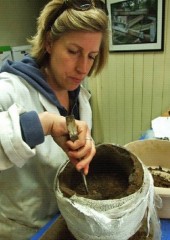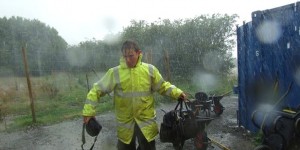How religious, how saintly a man you wish to appoint to such a holy see and above such a renowned and holy community of monks! I know most certainly that if by God's arrangement it happened thus, very quickly you would turn your hear and favour away from me, which is now great between us, and replace it with the most savage hatred. I know indeed that you would demand much, and even now you presume a great deal in ecclesiastical matters, which I would not be able to tolerate with equanimity. And so the envious would take advantage of the opportunity, and as soon as favour is extinguished they would stir up endless hatred between us.
<
p style="text-align: right">(Staunton 2001, 60)
-Thomas Becket's response to Henry II appointing him Chancellor and Archbishop, 1161-2.
Abstract/Aims
Archbishop Thomas Becket was murdered in Canterbury Cathedral on 27 December 1170 AD. Shortly thereafter in 1173 AD he was canonized into an already widely celebrated pilgrim cult site at Canterbury Cathedral, attracting both English and international pilgrims. Becket's shrine produced several different pilgrimage souvenirs including ampullae and badges (Blick 2007, 12). This paper investigates the archaeology of Thomas Becket through the distribution of his pilgrim badges in medieval England and Wales using the Portable Antiquities Scheme (PAS). Through an analysis of the county distributions of Becket badges, this paper will evaluate their greater implications in terms of patterns of 'local' pilgrimage in medieval England and Wales.
Introduction
The iconography of Thomas Becket can only be properly understood through the lens of his history, since Christian iconography at pilgrim cult sites frequently derived from the main events and symbols of a saint's life. Becket was born as 'Thomas of London' into a merchant family of Norman decent (Dugan 2004, 8). When Thomas was quite young, long-time family friend and aristocrat Richer de Laigle taught him elite social skills such as dining etiquette, hunting with dogs, and so forth (Dugan 2004, 9). Thomas was formally educated at an Augustinian Priory in London before briefly studying in Paris for less than two years (Staunton 2001, 42). Whilst in Paris he likely met the famous theologian John of Salisbury, who was studying in Paris at the same time and became one of Becket's strongest supporters later in life. At 21 years of age, Thomas left Paris and accepted a job as an assistant moneyer in London, where he met and gained the favour of Theobald, Archbishop of Canterbury (Dugan 2004, 12). Theobald sent Thomas to study law in Bologna for a year, after which he made Thomas an archdeacon of Canterbury in 1154 AD. Thus at a young age Thomas Becket had become a well-learned man, having studied at the world's most prestigious theology schools in Paris, law school in Bologna, and gaining a business background in finance. It was only fitting that Theobald recommended Thomas Becket as Henry II's new Chancellor. Henry and Thomas quickly become friends (Dugan 2004, 17). Thomas travelled with Henry on official business in England and France. Henry must have respected Thomas's intellect, since in 1161 he gave his eldest son to Becket's court for education (Dugan 2004, 18).
When Archbishop Theobald died on 18 April 1161, the archbishopric of Canterbury became available. Deciding between Thomas Becket (Theobald's choice) and Gilbert Foliot, Henry chose Becket, his close friend, who donned both Chancellor and Archbishop positions — hoping to use the opportunity to his advantage (Barlow 1986, 70). On 2 June 1162, Becket was ordained a priest and on the following day he was consecrated as bishop of Canterbury Cathedral (Barlow 1986, 72).
Yet Henry and Thomas's friendship took a turn for the worst in 1163. Wishing to hold corrupt and law-breaking clergy to a higher standard, the crown sought a greater emphasis on the 'ancient laws and customs' in the kingdom. Henry was consequently looking for Becket's support in the matter (Barlow 1986, 80). Several other disputes over Church and State arose and the two were at loggerheads for the majority of their relationship thereafter. In 1164 Thomas fled to France, where he would spend the next six years. In the midst of their disputes, Henry and Becket petitioned Pope Alexander III for advice and other Papal decrees. They both went on the offensive in 1166 when the former decreed numerous excommunications and interdicts on persons against him in England and the latter formulated the Assize of Clarendon 1166 (Staunton 2001, 145).
King Louis, Henry, and Thomas met several times during Thomas's exile and in July 1170 Thomas and Henry eventually came to terms (Barlow 1986, 210). Before returning to England in November, Thomas received Papal excommunications letters from Rome, which he had petitioned for in order to anathemize the Archbishop of York and the Bishop of London (Spencer 1998, 80-86). For the first event, Becket is usually depicted in a frontal view aboard a ship (Spencer 1998, fig. 34a) and for the latter event he is usually depicted riding majestically on horseback wearing his typical episcopal garb, including his famous pallium, mitre, and gloves (Spencer 1998, fig. 49b). The horse is portrayed in profile while Becket's torso and head are portrayed in a frontal view and his waist down in profile. Thomas had the excommunications delivered before his arrival, which further infuriated Henry, who later uttered the following famous words to his court: "What miserable drones and traitors have I nourished and promoted in my household, who let their lord be treated with such a shameful contempt by a low-born clerk!" (Barlow 1986, 235) In the false belief that they were following the King's direct orders, four mid-ranking baronial knights subsequently murdered Becket in his own cathedral, usually portrayed as Becket praying whilst four knights creep behind him, brandishing their swords (Spencer 1998, fig. 56a).
News of the assassination was quickly and widely disseminated; Knowles compares it to the Kennedy assassination in terms of its global shock (Knowles 1970, 150). The monks of the Abbey immediately collected Becket's blood and, despite the hectic atmosphere, prepared his body for a hasty funeral. Whilst a few monks were cleaning the dead Archbishop, they realized that he wore an unusual hair net and breeches, the latter associated with penance. Therefore, some Becket badges depict parts of his wardrobe, such as his mitre and gloves (Mitchiner 1986, figures 117-120). The monks also collected the broken sword of Richard le Bret, one of the murderers, which was preserved as a trophy in the shrine; this is commonly depicted as a scabbard and buckler in Becket badges (Spencer 1990, fig. 18) (Barlow 1986, 249).
Shortly after Becket's death, several miracle stories were reported, believed to be associated with the dead Archbishop: a vision which led a man to an image of Emperor Diocletian, long hidden in a mill; an account of taming wild dogs, healing swollen legs, and healing fevers (Staunton 2001, 207). People from all across Europe came to sample the famous healing 'water of St Thomas', supposedly produced by a mixture of his blood and water (Barlow 1986, 267). In February 1173 Thomas Becket was canonized, securing his place of death as a flourishing pilgrim cult centre. Thus, Becket's shrine was a common badge, usually depicting him lying in his coffin (Spencer 1998, fig. 73). More generic Becket badges, such as a bust of Becket and figures of him standing in his full episcopal garb, are also common (Spencer 1998, figs. 114 & 26d).
The Portable Antiquities Scheme
The Portable Antiquities Scheme (PAS) was founded in response to the Treasure Act of 1996, which stipulates that "all gold, silver, and groups of coins in the same findspot, which are over 300 years old, must be recorded" (Portable Antiquities Scheme, The British Museum). Since 2003, the Treasure Act also requires prehistoric metals be reported. The PAS covers England and Wales, although the scheme has contact information for Treasure Hunters in Scotland and North Ireland. As of 13 April 2012, the PAS has 496,322 records of 779,547 artefacts, which includes approximately 300,000 images (Portable Antiquities Scheme, The British Museum). There are over 2,125 different searchable object types in the PAS database, examples including, but not limited to, coins, ampullae, badges, amulets, beads, loomweights, rings, styli, tobacco pipes, and wicks. The Scheme is sustained by volunteer Mudlarks and Treasure Hunters reporting their finds to one of 39 regional PAS liaisons, who register these artefacts. Most of the finds are located using metal detectors. Every PAS record includes a unique artefact ID, chronological date and period, brief description, categorized object identity, dimensions and weight, materials and construction, spatial data, discovery dates, QR barcode, and often an artefact image to scale. There are currently 312 research projects that utilize the PAS, ranging from A-level archaeology projects to PhD dissertations and large-scale AHRC research.
The PAS and Thomas Becket Pilgrim Badges
The Portable Antiquities Scheme differentiates between pilgrim badges and secular badges, having labelled the first 'Pilgrim Badges' and the latter 'Badges'. Given variations in context and use, however, some artefacts that should be categorized as 'pilgrim badges' are mistakenly placed in the 'badges' category. Both categories were therefore used for this paper, and are referenced by the interchangeable terms 'pilgrim badges' or 'Becket badges'. Ampullae, an entirely different category in the PAS, were excluded from this analysis (Blick 2007, 12).
There are 241 badges and 271 pilgrim badges in the PAS (figures are as of 20 April 2012). The first step was to eliminate all pilgrim and secular badges after the medieval period; this removed 94 badges and 6 artefacts in the pilgrim badges category, leaving 411 artefacts in the data set. In 2007, 18 pilgrim badges were attributed to Thomas Becket; since then, however, the PAS has accumulated another 20 Becket badges (Egan et al. 2010, 209). To date, there are 40 identified Thomas Becket badges in the PAS, with an additional three badges that may be related.
CAM-3D1B83 (http://finds.org.uk/database/artefacts/record/id/239792), made of tin between 1400-1550 AD, depicts a pair of gloves; a common representation and badge sold of Thomas Becket at Canterbury. The iconography and shape are similar to Spencer 1998 figures 120, 120a, and 120b, the last artefact displaying the same dot-like ornamentation. The badge also resembles Mitchiner 1986 figures 119 and 120, as well as Spencer 1990 figure 38. The database only suggests a probable connection to Thomas Becket, although the iconography suggests a very strong connection.
LVPL-CDC3A5 (http://finds.org.uk/database/artefacts/record/id/145723), a copper allow pilgrim badge dating 1300-1500 AD, depicts a mitre — the vestment worn by a bishop. This symbol is a well-established icon signifying Thomas Becket, as seen in Spencer 1998 figure 119b.
WILT-8B9B83 (http://finds.org.uk/database/artefacts/record/id/113279), a lead badge dating 1301-1400 AD, depicts a male portrait encircled by a connecting chain of circles. The portrait is unfortunately blurry. However, the badge's style is similar to Spencer 1998 figure 6 and the rim's ornamentation resembles the typical decoration for Becket's pallium, as seen in Spencer 1998 figures 119a, 51b, 52; Spencer 1990 figure 12; and Mitchiner 1986 figure 96, to name a select few.
Other badges that resemble typical Becket badges are LIN-EEB323 (http://finds.org.uk/database/artefacts/record/id/199145), YORYM-7FC646 (http://finds.org.uk/database/artefacts/record/id/143722), and LON-0ADE06 (http://finds.org.uk/database/artefacts/record/id/111451). Unfortunately, these badges are too fragmentary or deteriorated to identify with conviction. LIN-EEB323 depicts a robed torso from the waist down, similar to the robe trim decoration of Mitchiner 1986 figure 96 and Spencer 1990 figure 12, although the piece is simply too fragmentary to identify with certainty. LON-0AAE06 depicts a robed individual from the neck down. The individual's stance is that of a typical Becket badge; however, the individual is not wearing a pallium, which is almost conventional in terms of the frequency with which it was used to depict Becket. Mitchiner 1986 figures 97 and 98 are exceptions to this iconography, although there are too many examples against this atypical style to identify the decapitated badge. Therefore, only the first three badges in question (CAM-3D1B83, LVPL-CDC3A5, and WILT-8B9B83) were added to the data set.
Discussion
The data set distribution is laid out in Table 1 (below):
| County | Number of Becket Badges |
|---|---|
| * The PAS distinguishes the Greater London Area as its own area. | |
| Cambridgeshire | 1 |
| Cheshire | 1 |
| Dorset | 2 |
| Isle of Wight | 1 |
| Kent | 2 |
| Lincolnshire | 8 |
| London* | 14 |
| Norfolk | 2 |
| Northampton | 1 |
| Surrey | 2 |
| Swansea, Wales | 1 |
| Warwickshire | 1 |
| Yorkshire | 3 |
| Wilshire | 1 |
| TOTAL | 3 |
The 40 badges, approximately 10% of the total medieval pilgrim badges in the PAS, are represented in 13 of England's 27 counties and one of Wales' 13 counties. The general distribution seems to match those medieval areas with a strong religious affinity or cult as well as those bordering counties: London includes Westminster Abbey's cult for St Edward the Confessor and neighbouring county Surrey, Kent's Canterbury Cathedral's cult for St Thomas Becket, Norfolk's Walsingham and Bornholm's cults and neighbouring Cambridgeshire and Lincolnshire. Other counties, such as Yorkshire and Lincolnshire, had massive cathedrals and smaller shrines (Yorkshire had one shrine and the seat of an archbishop, whereas Lincolnshire had two shrines) (Spencer 1998, 22-23). Yorkshire borders Cheshire in the data set and Lincoln, Northamptonshire. The distribution also features three badges in southern England in Dorset, Wiltshire, and the Isle of Wight.
The lacunae for distribution in England's southwest coast (including the Cornwall, Devon, and Somerset areas) is a curious aberration, as is the dearth of badges found in most of the English counties bordering Wales, such as Gloucestershire, Herefordshire, and Shropshire — not to mention the entirety of Wales excluding Swansea, and counties north of Yorkshire (Westmorland, Durham, Cumberland, and Northumberland). These oddities can be explained in several ways. First, the PAS has limitations. In a perfect world, one would assume that all counties are equally represented with medal detector users or avid history detectives who seek artefacts for the same amount of time per year, although such assumptions are false. It is also unlikely, given human nature, that all artefacts are reported to the PAS, although one cannot make this claim with certainty.
Another PAS limitation is that it fails to record museum or excavation artefacts found both before and after the PAS's establishment. These figures include the Museum of London's extensive collection, of which two Becket badges are on permanent display, as well as the British Museum's collection of approximately 73 Becket badges. Furthermore, the PAS does not account for any finds prior to 1996, which is a factor in any interpretation based on its data sets.
Nevertheless, the PAS is still a valuable resource for several reasons. First, it provides an open access database with a consistent register of artefacts discovered since 1996. Its database therefore consists of relatively 'new' finds, necessitating a new discussion of analyses based on similar finds in prior decades. However, given the numerous Becket badges found before the PAS was founded, a distribution map of this data set would not be a wholly accurate representation of national, let alone global, distribution of Becket badges. Second, the PAS succeeds as a relatively representative data set for a given area, in a similar vein to test-pit excavations, wherein artefacts are located from a 'random' search of a selected area. A researcher can assume that the results do not encompass the entire area, and thus use with confidence the resultant 'random' sampling as an acceptable representation. The PAS therefore provides a manageable, recent, and relatively accurate, representative data set for investigation.
If one accepts that the PAS data set for Becket badges is a reasonable 'random' representation of medieval material culture, inferences about historical pilgrimages to St Thomas Becket's shrine can be made. The general tendency toward higher badge counts in religiously affiliated counties suggests one of two things. First, clerics from eastern England likely travelled to Canterbury, the house of the Archbishop, and purchased Becket badges. This implies that pilgrim badges were marketed and sold to clerics, an idea that is beyond the limitations of this paper. Second, the tendency could suggest that St Thomas Becket's shrine, although the most popular in medieval England, attracted more 'local' visitors from neighbouring counties, or pilgrims from the South East, London, East-Midlands, East Anglia, and Yorkshire and Humberside regions, who were on their way to Santiago de Compostela. The distribution suggests that western pilgrims from the Southwest, West Midlands, Northwest, and Northeast regions generally did not travel to Canterbury to start the pilgrim trail in Continental Europe. A tendency for local travel is moreover supported by the four major cult sites in medieval England (Canterbury Cathedral, Walsingham, Westminster Abbey, and Bornholm), all of which are located in Eastern England and also appear in the data set.
Could this data set suggest an affinity for local cult sites within eastern England, and a similarly geographically-specific pattern in western counties? Although the latter sites are beyond the scope of this paper, the suggestion is plausible given the spatial distribution of badges within this data set. Perhaps pilgrims from western England and Wales were more likely to travel overseas because they were geographically closer to Santiago de Compostela, the most famous medieval pilgrim site, than inhabitants of eastern England.
To conclude, this paper set forth a brief catalogue (see Appendix) and county distribution of Becket badges in the Portable Antiquities Scheme (PAS). Secondly, it evaluated the greater implications of this distribution, suggesting that those who travelled to Canterbury tended to reside in eastern counties, thus implying a possible tendency toward 'local' pilgrimage in medieval England. Perhaps the greatest implication of this analysis is the advantage of using the PAS, which provides a 'new' data set for artefacts found in the last 16 years. The PAS database, if understood from the perspective of test-pit methodology and its concomitant assumptions, provides a relatively accurate 'random' sample of materials in the form of a manageable data that may suggest new avenues for historical investigation. Had this paper included all globally known Becket badges, it would have been beyond the time limitations and accessible resources available to complete this review — an investigation that must be relegated to future analysis, no doubt enriched by additions to the PAS in years to come.
Appendix
| Becket Badges | ||
|---|---|---|
Cambridgeshire
Chesire
Dorset
Isle of Wight
Kent
|
Lincolnshire
London
|
Norfolk
Northampton
Surrey
Swansea (Wales)
Warwickshire
Wiltshire
Yorkshire
|
Bibliography
- Barlow, F. (1986). Thomas Becket. Avon: The Bath Press.
- Blick, S. (ed.) (2007). Beyond Pilgrim Souvenirs and Secular Badges: essays in honour of Brian Spencer. Oxford: Oxbow Books.
- British Parliament Treasure Act 1996, Chapter 24 Sections 1-14.
- Dugan, A. (2004). Thomas Becket. New York: Oxford UP.
- Egan, G., Worrell, S. & Naylor, J. (eds.) (2010). A Decade in Discover: proceedings of the Portable Antiquities Scheme Conference 2007. Oxford: Hadrian Books Ltd.
- Knowles, D. (1970). Thomas Becket. London: Adam and Charles Black Ltd.
- Mitchiner, M. (1986). Medieval Pilgrim & Secular Badges. London: Hawkins Publications.
- Portable Antiquities Scheme, The British Museum:London, finds.org.uk.
- Spencer, B. (1966). 'Medieval Pelgrim Badges'. In Rotterdam Papers: a contribution to medieval archaeology. Cothen: Stichting Middeleeuwse Religieuze en Profane Insignes.
- Spencer, B. (1980). Medieval Pilgrim Badges from Norfolk. Hunstanton: Witley Press.
- Spencer, B. (1998). Pilgrim Souvenirs and Secular Badges: medieval finds from excavations in London. London: The Stationary Office.
- Spencer, B. (1990) Pilgrim Souvenirs & Secular Badges: Salisbury & South Wiltshire Museum Part 2. Over Wallop: BAS Printers Limited.
- Staunton, M. (2001). [trans.] The Lives of Thomas Becket. Manchester: Manchester UP.
Images Referenced in Text
- Mitchiner 1986.
- Spencer 1990.
- Spencer 1998.
- The Portable Antiquity Scheme, The British Museum.
Paul Brazinski is an MPhil student at the University of Cambridge.









